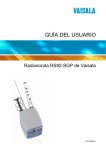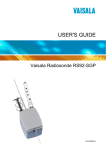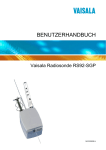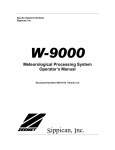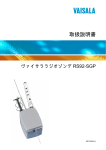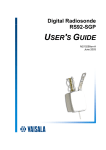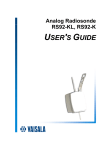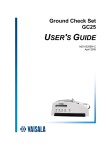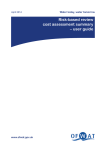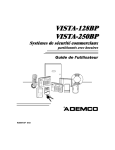Download Vaisala RS92-D User`s guide
Transcript
USER'S GUIDE Vaisala Radiosonde RS92-D M210987EN-C PUBLISHED BY Vaisala Oyj Phone (int.): +358 9 8949 1 P.O. Box 26 Fax: +358 9 8949 2227 FIN-00421 Helsinki Finland Visit our Internet pages at http://www.vaisala.com/ © Vaisala 2010 No part of this manual may be reproduced in any form or by any means, electronic or mechanical (including photocopying), nor may its contents be communicated to a third party without prior written permission of the copyright holder. The contents are subject to change without prior notice. Please observe that this manual does not create any legally binding obligations for Vaisala towards the customer or end user. All legally binding commitments and agreements are included exclusively in the applicable supply contract or Conditions of Sale. ________________________________________________________________________________ Table of Contents CHAPTER 1 GENERAL INFORMATION . . . . . . . . . . . . . . . . . . . . . . . . . . . . . . . . . . . . . . 7 About This Manual . . . . . . . . . . . . . . . . . . . . . . . . . . . . . . . . . 7 Contents of This Manual . . . . . . . . . . . . . . . . . . . . . . . . . . . 7 Version Information . . . . . . . . . . . . . . . . . . . . . . . . . . . . . . . 8 Related Manuals . . . . . . . . . . . . . . . . . . . . . . . . . . . . . . . . . 8 General Safety Considerations . . . . . . . . . . . . . . . . . . . . . . 8 Feedback . . . . . . . . . . . . . . . . . . . . . . . . . . . . . . . . . . . . . . . 9 Product-Related Safety Precautions . . . . . . . . . . . . . . . . . . . 9 Recycling . . . . . . . . . . . . . . . . . . . . . . . . . . . . . . . . . . . . . . . . . 9 License Agreement . . . . . . . . . . . . . . . . . . . . . . . . . . . . . . . . 10 CHAPTER 2 PRODUCT OVERVIEW . . . . . . . . . . . . . . . . . . . . . . . . . . . . . . . . . . . . . . . 11 Introduction to Vaisala Radiosonde RS92-D . . . . . . . . . . . 11 CHAPTER 3 OPERATION . . . . . . . . . . . . . . . . . . . . . . . . . . . . . . . . . . . . . . . . . . . . . . . . 13 General . . . . . . . . . . . . . . . . . . . . . . . . . . . . . . . . . . . . . . . . . . 13 Preparing the Balloon and Optional Sounding Accessories . . . . . . . . . . . . . . . . . . . . . . . . . . . . . . . . . . . . . . 14 Balloon Preparation . . . . . . . . . . . . . . . . . . . . . . . . . . . . . . 14 Optional Sounding Accessories . . . . . . . . . . . . . . . . . . . . . 18 Totex Parachute 5710-5 . . . . . . . . . . . . . . . . . . . . . . . 18 Radar Reflector . . . . . . . . . . . . . . . . . . . . . . . . . . . . . . 19 Non-Totex Parachute. . . . . . . . . . . . . . . . . . . . . . . . . . 19 Unpacking the Radiosonde . . . . . . . . . . . . . . . . . . . . . . . . . 21 Preparing the Sounding . . . . . . . . . . . . . . . . . . . . . . . . . . . . 23 Connecting the Battery Set . . . . . . . . . . . . . . . . . . . . . . . . . 25 General . . . . . . . . . . . . . . . . . . . . . . . . . . . . . . . . . . . . . . . 25 Connecting the Battery . . . . . . . . . . . . . . . . . . . . . . . . . . . 26 Removing the Battery Case . . . . . . . . . . . . . . . . . . . . . . . . 28 Launching the Radiosonde . . . . . . . . . . . . . . . . . . . . . . . . . 28 Attaching the Unwinder . . . . . . . . . . . . . . . . . . . . . . . . . . . 28 Attaching the Unwinder to the Balloon. . . . . . . . . . . . . 29 Totex Parachute . . . . . . . . . . . . . . . . . . . . . . . . . . . . . 29 Radar Reflector . . . . . . . . . . . . . . . . . . . . . . . . . . . . . . 30 Non-Totex Parachute. . . . . . . . . . . . . . . . . . . . . . . . . . 30 Releasing the Balloon . . . . . . . . . . . . . . . . . . . . . . . . . . . . 30 Checking the Reception . . . . . . . . . . . . . . . . . . . . . . . . . . . 30 Monitoring the Sounding . . . . . . . . . . . . . . . . . . . . . . . . . . . 30 VAISALA ________________________________________________________________________ 1 User's Guide ______________________________________________________________________ CHAPTER 4 STORAGE AND TRANSPORTATION . . . . . . . . . . . . . . . . . . . . . . . . . . . .31 Storage . . . . . . . . . . . . . . . . . . . . . . . . . . . . . . . . . . . . . . . . . .31 Transportation . . . . . . . . . . . . . . . . . . . . . . . . . . . . . . . . . . . .32 Transporting Lithium Batteries and RS92 Radiosondes . .32 CHAPTER 5 FAILURE REPORT AND WARRANTY . . . . . . . . . . . . . . . . . . . . . . . . . . .35 Failure Report . . . . . . . . . . . . . . . . . . . . . . . . . . . . . . . . . . . .35 Technical Support . . . . . . . . . . . . . . . . . . . . . . . . . . . . . . . . .36 Radiosonde Warranty . . . . . . . . . . . . . . . . . . . . . . . . . . . . . .36 Vaisala Radiosonde Warranty Statement . . . . . . . . . . . . .36 Storage Conditions . . . . . . . . . . . . . . . . . . . . . . . . . . . 37 Transportation and Handling . . . . . . . . . . . . . . . . . . . . 37 Criteria for Radiosonde Failures . . . . . . . . . . . . . . . . . 37 Making Warranty Claims . . . . . . . . . . . . . . . . . . . . . . . 38 APPENDIX A SAFETY INSTRUCTIONS FOR BALLOON OPERATORS . . . . . . . . . . . .39 2 ___________________________________________________________________ M210987EN-C ________________________________________________________________________________ List of Figures Figure 1 Figure 2 Figure 3 Figure 4 Figure 5 Figure 6 Figure 7 Figure 8 Figure 9 Figure 10 Figure 11 Figure 12 Figure 13 Figure 14 Figure 15 Figure 16 Figure 17 Figure 18 Figure 19 Figure 20 Figure 21 Vaisala Radiosonde RS92-D . . . . . . . . . . . . . . . . . . . . . . . . . . 12 Loading Weights onto the Gas Nozzle. . . . . . . . . . . . . . . . . . . 14 Attaching the Balloon to the Gas Nozzle . . . . . . . . . . . . . . . . . 15 Inflating the Balloon . . . . . . . . . . . . . . . . . . . . . . . . . . . . . . . . . 15 Balloon Raises the Gas Nozzle . . . . . . . . . . . . . . . . . . . . . . . . 16 Securing the Neck of the Balloon. . . . . . . . . . . . . . . . . . . . . . . 16 Removing the Balloon from the Gas Nozzle . . . . . . . . . . . . . . 17 Folding the Neck of the Balloon . . . . . . . . . . . . . . . . . . . . . . . . 17 Vaisala Radiosonde Sounding Accessories. . . . . . . . . . . . . . . 20 Opening the Foil Bag . . . . . . . . . . . . . . . . . . . . . . . . . . . . . . . . 21 Contents of the Radiosonde Package . . . . . . . . . . . . . . . . . . . 21 Placing the Antenna Into Flight Position . . . . . . . . . . . . . . . . . 22 Unwinder Details . . . . . . . . . . . . . . . . . . . . . . . . . . . . . . . . . . . 22 Placing the Sensor Boom into Flight Position . . . . . . . . . . . . . 24 RSB511 Dry-cell Battery Set (Number 1) and RSB611 Lithium Battery (Number 2) . . . . . . . . . . . . . . . . . . . . . . . . . . . 25 Battery Package. . . . . . . . . . . . . . . . . . . . . . . . . . . . . . . . . . . . 26 Battery Connector Shown with RSB611 . . . . . . . . . . . . . . . . . 26 Connecting the Battery Connector to the Radiosonde. . . . . . . 27 Removing the Battery Case . . . . . . . . . . . . . . . . . . . . . . . . . . . 28 Attaching the Unwinder to the Balloon . . . . . . . . . . . . . . . . . . . 29 Lithium Battery Handling Label . . . . . . . . . . . . . . . . . . . . . . . . 33 VAISALA ________________________________________________________________________ 3 User's Guide ______________________________________________________________________ 4 ___________________________________________________________________ M210987EN-C ________________________________________________________________________________ List of Tables Table 1 Table 2 Table 3 Table 4 Manual Versions . . . . . . . . . . . . . . . . . . . . . . . . . . . . . . . . . . . . . 8 Related Manuals . . . . . . . . . . . . . . . . . . . . . . . . . . . . . . . . . . . . . 8 Ordering Codes for Optional Sounding Accessories . . . . . . . . . . 18 RS92-D Battery Sets . . . . . . . . . . . . . . . . . . . . . . . . . . . . . . . . . . 25 VAISALA ________________________________________________________________________ 5 User's Guide ______________________________________________________________________ 6 ___________________________________________________________________ M210987EN-C Chapter 1 ________________________________________________________ General Information CHAPTER 1 GENERAL INFORMATION This chapter provides general notes for the manual and the product. About This Manual This manual provides information for operating the Vaisala Radiosonde RS92-D. Contents of This Manual This manual consists of the following chapters: - Chapter 1, General Information: This chapter provides general notes for the manual and the product. - Chapter 2, Product Overview: This chapter introduces the features and advantages of the radiosonde. - Chapter 3, Operation: This chapter contains information that is needed to operate this product. - Chapter 4, Storage and Transportation: This chapter provides information for the transport and storage of the product. - Chapter 5, Failure Report and Warranty: This chapter presents information about the failure report and radiosonde warranty. - Appendix A, Safety Instructions for Balloon Operators: This appendix contains details of safe and proper balloon preparation. VAISALA ________________________________________________________________________ 7 User's Guide ______________________________________________________________________ Version Information Table 1 Manual Versions Manual Code Description M210987EN-C May 2010. Updated instructions for transporting lithium batteries. January 2010. For RS92-DD and RS92-DL. June 2009. For RS92-DD only M210987EN-B M210987EN-A Related Manuals Table 2 Related Manuals Manual Code Manual Name M010117EN M210329EN M211025EN Radiotheodolite RT20A and DigiCORA® Ground Check Set GC25 User’s Guide Configuring and Operating MW12, RT20 Systems and RS92 Radiosondes General Safety Considerations Throughout the manual, important safety considerations are highlighted as follows: WARNING Warning alerts you to a serious hazard. If you do not read and follow instructions very carefully at this point, there is a risk of injury or even death. CAUTION Caution warns you of a potential hazard. If you do not read and follow instructions carefully at this point, the product could be damaged or important data could be lost. NOTE Note highlights important information on using the product. 8 ___________________________________________________________________ M210987EN-C Chapter 1 ________________________________________________________ General Information Feedback Vaisala Customer Documentation Team welcomes your comments and suggestions on the quality and usefulness of this publication. If you find errors or have other suggestions for improvement, please indicate the chapter, section, and page number. You can send comments to us by email: [email protected]. Product-Related Safety Precautions WARNING Conduct soundings in a safe environment and in accordance with all applicable restrictions and regulations. WARNING Do not use the radiosonde in an area with power lines or other obstructions overhead. Make sure that you check the area for such obstructions before using the radiosonde. WARNING Do not use the radiosonde without consultation and cooperation with local and other applicable aviation authorities. CAUTION Do not modify the unit. Improper modification can damage the product or lead to malfunction. CAUTION Do not use the radiosonde for any purpose other than for soundings. Recycling Recycle all applicable material. VAISALA ________________________________________________________________________ 9 User's Guide ______________________________________________________________________ Dispose of batteries and the unit according to statutory regulations. Do not dispose of with regular household refuse. License Agreement All rights to any software are held by Vaisala or third parties. The customer is allowed to use the software only to the extent that is provided by the applicable supply contract or Software License Agreement. 10 __________________________________________________________________ M210987EN-C Chapter 2 __________________________________________________________ Product Overview CHAPTER 2 PRODUCT OVERVIEW This chapter introduces the features and advantages of the radiosonde. Introduction to Vaisala Radiosonde RS92-D The digital Vaisala Radiosonde RS92-D offers excellent accuracy in humidity, pressure, temperature, and wind measurement. The radiosonde features digital data transmission, which offers important advantages over analog data transmission. Data availability during a sounding is excellent, and telemetry errors are always detected. The digital transmitter also consumes less power than an analog transmitter, and more channels are available in the meteorological frequency band. The sounding system used with RS92-D reads the calibration coefficients stored in the radiosonde memory via a cable or telemetry link. The humidity sensors can be reconditioned to remove any chemical contaminants to ensure excellent humidity measurement accuracy. The RS92-D is compliant with the European ETSI standard for digital radiosondes operating in the 1680 MHz band, EN 302 054. The radiosonde transmitter frequency can be set electronically. VAISALA _______________________________________________________________________ 11 User's Guide ______________________________________________________________________ 0705-015 Figure 1 Vaisala Radiosonde RS92-D 1 = Temperature sensor 2 = Humidity sensors 3 = Sensor boom 4 = Additional sensor interface connector 5 = Battery case 6 = GC25/Radiosonde cable interface 7 = Antenna 12 __________________________________________________________________ M210987EN-C Chapter 3 ________________________________________________________________ Operation CHAPTER 3 OPERATION This chapter contains information that is needed to operate this product. General It is essential that you carry out the pre-launch steps as instructed and always in the same way. Follow the instructions in the sections below and refer to Appendix A on page 39 for proper and safe balloon preparation. The workorder for a sounding is as follows: 1. Prepare the balloon and optional sounding accessories. 2. Unpack the radiosonde. 3. Prepare the sounding. 4. Connect the battery. 5. Launch the radiosonde. 6. Monitor the sounding with the sounding system. VAISALA _______________________________________________________________________ 13 User's Guide ______________________________________________________________________ Preparing the Balloon and Optional Sounding Accessories The balloon and the optional sounding accessories must be prepared before connecting the radiosonde battery and thereby activating the radiosonde. This is necessary because the radiosonde should be launched within 15 minutes of battery connection. WARNING Read the safety instructions in Appendix A before proceeding. Normally the balloon-lifting gas (hydrogen or helium) is supplied in gas bottles, but hydrogen can also be produced with a hydrogen generator. Carefully study the operation and safety instructions for the gas bottle facilities or the hydrogen generator. Take extreme caution when handling the inflated balloon. Balloon Preparation WARNING It is recommended that the balloon be prepared in a balloon filling shed. The balloon filling shed must be well ventilated so that possible gas leaks do not remain inside the shed, even in situations when there is no electricity. Follow these steps to prepare the balloon: 1. Load weights that are needed to obtain the required lift onto the gas nozzle. 0705-020 Figure 2 Loading Weights onto the Gas Nozzle 14 __________________________________________________________________ M210987EN-C Chapter 3 ________________________________________________________________ Operation 2. Attach the balloon to the gas nozzle by securing the balloon with a piece of string or a clamp. 0705-017 Figure 3 3. Inflate the balloon following the balloon manufacturer’s inflation instructions. Do not leave the balloon-filling shed while inflating the balloon. 0705-018 Figure 4 4. Attaching the Balloon to the Gas Nozzle Inflating the Balloon When the balloon is sufficiently filled, in other words, the balloon just raises the gas nozzle, close the gas valve. VAISALA _______________________________________________________________________ 15 User's Guide ______________________________________________________________________ 0705-019 Figure 5 5. Balloon Raises the Gas Nozzle Secure the neck of the balloon tightly with a string before removing the balloon from the gas nozzle. 0706-105 Figure 6 Securing the Neck of the Balloon 16 __________________________________________________________________ M210987EN-C Chapter 3 ________________________________________________________________ Operation 0705-021 Figure 7 6. Fold the neck of the balloon over and secure it firmly. Tie the string high enough to ensure that the unwinder fits easily. 0705-022 Figure 8 7. Removing the Balloon from the Gas Nozzle Folding the Neck of the Balloon Leave the balloon waiting in the balloon-filling shed while you prepare the radiosonde. Make sure the balloon does not touch anything. Hold the balloon by the neck. VAISALA _______________________________________________________________________ 17 User's Guide ______________________________________________________________________ NOTE When using a balloon with an integrated parachute, make sure that a sufficiently long piece of the parachute string is poking out of the balloon neck in order to fasten the string to the radiosonde unwinder. Optional Sounding Accessories The RS92 unwinder RSU911 is designed to be attached directly to the folded balloon neck. However, you can use the same unwinder if you use optional sounding accessories, such as a parachute or a radar reflector. Always attach the unwinder to a relatively firm support, such as the balloon or the parachute spreader. The support must not let the unwinder twist freely, or otherwise the suspension string might unwind at too high a speed and the radiosonde hit the ground during the launch. The unwinder must also be able to swing slightly during the sounding. Attach all optional sounding accessories next to the balloon, or otherwise they disturb the measuring environment of the radiosonde and no proper temperature and humidity measurements can be made. CAUTION The strength of all the strings used during soundings must exceed 25 kp (250 N). Knots in the strings weaken the strength to the minimum of 40 % of the original string strength. This results in a string strength of 10 kp (100 N), which is sufficient for RS92 soundings. Table 3 Ordering Codes for Optional Sounding Accessories Item Code Note Totex parachute Rubber plate Hanger board 15046 RS46158 RS46157 Used with a radar reflector Used with a non-Totex parachute Totex Parachute 5710-5 The recommended parachute is the Totex type 5710-5 (Vaisala code 15046). In the Totex parachute, an elastic ribbon loop hangs the unwinder securely under the spreader. Attach the parachute directly to the balloon with the parachute string. 18 __________________________________________________________________ M210987EN-C Chapter 3 ________________________________________________________________ Operation See Figure 9 on page 20 for details. For unwinder attaching instructions, see section Totex Parachute on page 29. Radar Reflector Attach the unwinder to the radar reflector with a rubber plate accessory (Vaisala code RS46158). The rubber plate accessory lets the unwinder swing properly, making sure that the suspension string is unwound smoothly. 1. Tie the radar reflector to the balloon with a string of approximately 50 cm in length. 2. Attach the rubber plate (RS46158) to the radar reflector. See Figure 9 on page 20 for details. For unwinder attaching instructions, see section Radar Reflector on page 30. Non-Totex Parachute If you are using a parachute that has no firm objects to prevent the unwinder from twisting, you have to use a hanger board (Vaisala code RS46157). 1. Tie the parachute to the balloon with a string. 2. Tie the hanger board to the parachute with a string of approximately 20 cm in length. See Figure 9 on page 20 for details. For unwinder attaching instructions, see section Non-Totex Parachute on page 30. VAISALA _______________________________________________________________________ 19 User's Guide ______________________________________________________________________ 0906-090 Figure 9 Vaisala Radiosonde Sounding Accessories Option 1 = Sounding with a Totex parachute Option 2 = Sounding with no sounding accessories Option 3 = Sounding with a radar reflector Option 4 = Sounding with a non-Totex Parachute Now you can proceed to unpack the radiosonde. 20 __________________________________________________________________ M210987EN-C Chapter 3 ________________________________________________________________ Operation Unpacking the Radiosonde Follow these steps to unpack the radiosonde: CAUTION Do not touch or hit the sensors on the sensor boom. By carefully handling the radiosonde and the sensor boom, you ensure that the radiosonde functions properly during the sounding. 1. Open the foil bag as indicated on the bag. 0912-232 Figure 10 2. Opening the Foil Bag Lift the cardboard flap protecting the sensor boom. Be careful to avoid touching or hitting the sensors on the sensor boom. 0912-138 Figure 11 Contents of the Radiosonde Package 1 = Radiosonde 2 = Unwinder 3 = Battery VAISALA _______________________________________________________________________ 21 User's Guide ______________________________________________________________________ 3. Remove the radiosonde from the package, straighten the antenna, and take the unwinder out of the package. 1002-102 Figure 12 4. Placing the Antenna Into Flight Position Remove the small plastic rubber wire from the unwinder. 0601-048 Figure 13 Unwinder Details 1 = Rubber wire 2 = Unwinder lip 5. Make sure the plastic lip under which the string runs is level with the unwinder bottom plate. If the lip is bent, bend it gently back to level the position. Proceed to prepare the sounding. 22 __________________________________________________________________ M210987EN-C Chapter 3 ________________________________________________________________ Operation Preparing the Sounding NOTE Radiosonde RS92-D is typically operated with the radiosonde cable or by reading the calibration coefficients via radio. See the relevant sounding system manuals for details. For instructions on using the Ground Check Set GC25, see Ground Check Set GC25 User’s Guide. Follow these steps to prepare the sounding: CAUTION 1. Start a new sounding with the sounding system. The sounding system goes through reconditioning, frequency tuning, and timer setting. For detailed instructions, see the relevant sounding system manuals. 2. When prompted, connect the radiosonde cable to the GC25/ radiosonde cable interface in the radiosonde. Text "UP" on the connector faces upwards. 3. When the sounding system is finished, the message "Ready for sonde release!" appears on the display. Disconnect the radiosonde cable. 4. Set the sensor boom into flight position; Back of the radiosonde facing you, press the sensor boom gently forward with your thumbs until the plastic clips on both sides of the sensor boom click (you may have to spread the plastic clips slightly) and the sensor boom sits firmly in the bent position. Only touch the bottom of the boom. Do not touch or hit the sensors. VAISALA _______________________________________________________________________ 23 User's Guide ______________________________________________________________________ 0905-083 Figure 14 Placing the Sensor Boom into Flight Position The sensor boom is now in the flight position and remains so throughout the sounding. Now proceed to connect the radiosonde battery. 24 __________________________________________________________________ M210987EN-C Chapter 3 ________________________________________________________________ Operation Connecting the Battery Set General The RS92-D battery set ordering codes are given in Table 4 on page 25. Table 4 RS92-D Battery Sets Ordering Code Battery Description RS92-DD RS92-DL RSB511 RSB611 Dry-cell Battery Set Lithium Battery Set 1001-135 Figure 15 RSB511 Dry-cell Battery Set (Number 1) and RSB611 Lithium Battery (Number 2) VAISALA _______________________________________________________________________ 25 User's Guide ______________________________________________________________________ Connecting the Battery Follow these steps to connect the battery to the radiosonde: 1. Open the foil bag as indicated on the bag. 0912-138 Figure 16 2. Battery Package Take out the battery connector (number 1 in Figure 17 on page 26) by gently pulling the wires. 0912-140 Figure 17 Battery Connector Shown with RSB611 26 __________________________________________________________________ M210987EN-C Chapter 3 ________________________________________________________________ Operation 3. Connect the battery connector (number 1 in Figure 18 on page 27) to the radiosonde (number 2). 0912-141 Figure 18 Connecting the Battery Connector to the Radiosonde 4. The radiosonde has now been activated. Close the battery case. 5. Check from the sounding system software that the telemetry link is working well. For detailed instructions on using the sounding software, refer to the sounding system user manuals. The radiosonde is now prepared for launch. In order to ensure 120 minutes of flight time, it is recommended that the radiosonde is launched within 15 minutes of battery connection. Proceed now to launch the radiosonde. VAISALA _______________________________________________________________________ 27 User's Guide ______________________________________________________________________ Removing the Battery Case If you need to remove the battery case from the radiosonde, use, for example, a small coin to loosen the battery case. Push the coin into the small opening between the radiosonde and the battery case to loosen the case and remove it. See Figure 19 on page 28. 0809-005 Figure 19 Removing the Battery Case Launching the Radiosonde The radiosonde is now ready for launch. Attaching the Unwinder The unwinder is used to unwind the suspension string gently and slowly. To do this, the unwinder must be attached firmly, so that it does not rotate relative to the balloon. If the unwinder moves freely, the suspension string unwinds too quickly, and it is possible that the radiosonde hits the ground upon launch. The unwinder is designed to be tied directly to the balloon. If you cannot attach the unwinder directly to the balloon, for example, when using a radar reflector or a parachute, sounding accessories are 28 __________________________________________________________________ M210987EN-C Chapter 3 ________________________________________________________________ Operation needed to restrict the movement of the unwinder. For instructions, refer to section Optional Sounding Accessories on page 18. Attaching the Unwinder to the Balloon Follow these steps to attach the unwinder directly to the balloon: 1. Pass the unwinder hook through the loop created by the tied balloon neck. 2. Make sure that the hook comes out the other side, as shown in Figure 20 on page 29. The unwinder is now attached firmly to the balloon. If you are using a balloon with an integrated parachute, fasten the parachute string poking out of the balloon neck to the unwinder. 0705-042 Figure 20 Attaching the Unwinder to the Balloon If you use optional sounding accessories, follow these instructions to attach the unwinder. Totex Parachute The Totex parachute 5710-5 has an elastic ribbon loop below the spreader. Attach the unwinder to the loop by pushing the hook out the VAISALA _______________________________________________________________________ 29 User's Guide ______________________________________________________________________ other side in the same fashion as with the folded balloon neck (see section Attaching the Unwinder to the Balloon on page 29). Radar Reflector There is a rubber plate attached to the radar reflector. Attach the unwinder to this plate. Non-Totex Parachute There is a hanger board tied to the parachute. Attach the unwinder to the bottom of the hanger board. Releasing the Balloon In order to ensure 120 minutes of flight time, the radiosonde should be launched within 15 minutes of battery connection. Follow these steps to release the balloon: 1. Make sure the suspension string is not tangled. 2. Hold the unwinder to prevent the string from running out before the release. 3. Release the balloon and allow the radiosonde to lift from your hand. Keep the string length between the radiosonde and the unwinder as short as possible. Checking the Reception Immediately after the release, check the reception of the radiosonde frequency on the receiver. Proceed to monitor the sounding with the sounding system. Monitoring the Sounding If you have not already done so, enter the surface observation information in the sounding system. Refer to the sounding system’s user manual for detailed instructions on using the sounding system software. 30 __________________________________________________________________ M210987EN-C Chapter 4 __________________________________________________ Storage and Transportation CHAPTER 4 STORAGE AND TRANSPORTATION This chapter provides information for the transport and storage of the product. Storage Radiosondes must be stored and used properly in accordance with applicable instructions, the User’s Guide, and specifications issued by Vaisala. Proper storage conditions must fulfill the following requirements: Radiosondes must be kept in their original packaging (unopened vacuum envelopes) in a dry, ventilated indoor storage space, and within the following key environmental limits (ref. IEC 60721-3-1 class 1K2): CAUTION - Temperature +5 °C to +40 °C - Relative humidity below 85% The suspension string is not resistant to prolonged exposure to sunlight. Store the radiosondes in their original unopened vacuum envelopes. VAISALA _______________________________________________________________________ 31 User's Guide ______________________________________________________________________ Transportation Vaisala radiosondes must be transported in their original shipping packages. These packages are designed and built to survive and protect their contents in the environmental conditions described herein with the terminology and standards per standard: IEC 60721-3-2. The transportation of radiosondes requires climatic conditions 2K2 and mechanical conditions 2M1 of this standard: - Transportation in weather-protected conditions. - Transportation using conventional means (car, truck, and/or aircraft), with free fall not exceeding 0.25 m in any circumstances. - Following additional markings on packaging. Do not transport the radiosonde with the battery connected. Transporting Lithium Batteries and RS92 Radiosondes RSB611 lithium batteries and RS92 radiosondes with lithium batteries are classified as: - UN 3090 Lithium metal batteries - UN 3091 Lithium metal batteries packed with equipment Consignments must be packed, labeled, and documented according to the IATA packing instructions. When transporting the radiosondes with lithium batteries, take the following requirements into account: - The package must display a lithium battery handling label, see Figure 21 on page 33 for an example. The original radiosonde shipping should be used for transport, and it already has the lithium battery handling label. - The consignment must include a document indicating the lithium content, describing proper handling and procedures for damaged packages, and a telephone number for additional information. The original radiosonde consignment includes a SHIPPER'S DECLARATION FOR ARTICLES NOT REGULATED AS 32 __________________________________________________________________ M210987EN-C Chapter 4 __________________________________________________ Storage and Transportation DANGEROUS GOODS, which should be reused for this purpose after updating the appropriate information. 1002-100 Figure 21 NOTE Lithium Battery Handling Label If the lithium battery is faulty, do not transport it. VAISALA _______________________________________________________________________ 33 User's Guide ______________________________________________________________________ 34 __________________________________________________________________ M210987EN-C Chapter 5 _________________________________________________ Failure Report and Warranty CHAPTER 5 FAILURE REPORT AND WARRANTY This chapter presents information about the failure report and radiosonde warranty. Failure Report In case of some malfunction, write a failure report consisting of the following issues: - What failed (what worked / did not work)? - Where did it fail (location and environment)? - When did it fail (date, immediately / after a while / periodically / randomly)? - How many failed (only one defect / other same or similar defects / several failures in one unit)? - What was connected to the product and to which connectors? - What was done when the failure was noticed? Include the radiosonde serial number in the failure report. VAISALA _______________________________________________________________________ 35 User's Guide ______________________________________________________________________ Technical Support For technical questions, contact the Vaisala technical support: E-mail [email protected] Fax +358 9 8949 2790 If the product needs repair, please follow the instructions below to speed up the process and to avoid extra costs to you. NOTE 1. Read the warranty information. 2. Contact Vaisala technical support via e-mail or fax and request for RMA (Return Material Authorization) and shipping instructions. 3. Proceed as instructed by Vaisala technical support. RMA must always be requested from Vaisala technical support before returning any faulty material. Radiosonde Warranty The following Vaisala Radiosonde general warranty statement is effective as of 02/2007. However, please refer to the applicable supply contract for the specifics of your warranty terms. If there is a discrepancy between the general radiosonde warranty statement and the radiosonde warranty statement in the supply contract, the provisions of the official radiosonde warranty statement in the supply contract prevail. Vaisala Radiosonde Warranty Statement Vaisala repairs or, at its discretion, replaces any Vaisala RS92 radiosonde that is proven, with reasonable satisfaction, to have failed within 13 months of shipment by reason of faulty materials or workmanship, under the following conditions and provided that radiosonde is stored and used properly in accordance with applicable instructions and manuals issued by Vaisala. 36 __________________________________________________________________ M210987EN-C Chapter 5 _________________________________________________ Failure Report and Warranty Storage Conditions Radiosonde shall be stored indoors in its original unopened vacuum envelope within the following environmental limits: - temperature +5 °C to +40 °C - relative humidity below 85 % Additional storage requirements for Vaisala AUTOSONDE: - the maximum number of days radiosonde can be loaded in AUTOSONDE is 14 - relative humidity below 50 % - temperature +15 °C to +35 °C Transportation and Handling Radiosondes shall be transported in the original shipping packaging, which is designed and built to survive and protect the contents in the environmental conditions specified in standard IEC 60721-3-2: climatic conditions of class 2K2, and mechanical conditions of class 2M1 of the standard are required. Instructions on the packaging for transportation and handling shall be followed. Criteria for Radiosonde Failures Pre-flight failures under warranty: - Radiosonde fails during the sounding preparation, or ground check correction exceeds one of the following limits: P: ± 3 hPa T: ± 1 °C U: ± 4 %RH (at 0 % RH) In-flight failures below altitude of 100 hPa under warranty: - Radiosonde stops transmitting one or more parameters - Radiosonde transmits clearly erroneous data - There is a continuous telemetry link failure exceeding 2 minutes VAISALA _______________________________________________________________________ 37 User's Guide ______________________________________________________________________ Early termination of sounding caused by balloon burst, user error, or any external cause, is not covered by this warranty. Making Warranty Claims A failure report shall be provided for each failed radiosonde stating the radiosonde serial number, a description of the failure, and sounding site and date. A template provided by Vaisala can be used for this. A radiosonde found defect prior to launch shall be returned to the nearest Vaisala office. Report of an in-flight failure shall be accompanied by either 1) sounding data file (MW21, MW31 and AUTOSONDE systems) or 2) sounding status report printout (MW11/MW12/MW15 systems) for each failed sounding. Failure report and any radiosonde failed prior to launch shall be sent to Vaisala within 180 days after the failure, or within a year from extremely remote or shipborne stations. 38 __________________________________________________________________ M210987EN-C Appendix A _______________________________________ Safety Instructions for Balloon Operators APPENDIX A SAFETY INSTRUCTIONS FOR BALLOON OPERATORS This appendix contains details of safe and proper balloon preparation. Photocopy these instructions and place the list in clear view in the balloon-filling shed and in the sounding compartment. 1. No smoking or naked flame allowed. 2. If possible, avoid wearing clothing made of nylon or other synthetic fibers to prevent a build-up of static charges. Do not wear shoes with rubber soles. 3. Wear protective glasses. 4. Regularly check that the gas tube fits securely to the gas cylinder or generator nozzle and to the balloon inflation nozzle. 5. Take care to prevent a gas leak in the shed when interrupting inflation to replace a gas cylinder. 6. Never use a repaired balloon. 7. Should a leak develop in the balloon during inflation, do not let gas escape from the balloon inside the shed if possible. Instead, release the defective balloon without load. It is not advisable to deflate the balloon, even outside the shed. 8. Do not touch the balloon with bare hands except when holding it by the neck. Wear soft cotton gloves. 9. Ensure that there are no pointed objects in the shed. Nails, hooks, hinges, padlocks, etc., are dangerous as they might scratch the VAISALA _______________________________________________________________________ 39 User's Guide ______________________________________________________________________ inflated balloon. The balloon film is only 0.05 ... 0.1 mm thick upon launch; the slightest scratch could cause the balloon to burst prematurely. 10. Keep the doors of the shed shut while inflating the balloon on a windy day. However, ensure that the shed is properly ventilated. 11. No unauthorized person shall be allowed admittance to the shed while the hydrogen generator is in operation or balloon inflation is going on. 12. Ensure that all tools and other implements not essential for balloon inflation have been removed from the shed. 13. Do not take any electrical devices (cell phone etc.) to the balloon filling shed or close to the balloon inflated with hydrogen. Safe distance when outdoors is typically 1.5 meters. 14. Always keep the radiosonde at least 50 cm below the level of the gas nozzle and the inflated balloon, and at least 1.5 meters away from the gas cylinder/hydrogen generator, connectors, and tubing. Avoid taking the radiosonde inside the balloon filling shed, if possible. 15. Follow all regulations concerning hydrogen safety. WARNING New operator! Carefully study the instructions for using the hydrogen generator and for the correct method of inflation. 40 __________________________________________________________________ M210987EN-C ____________________________________________________________________________ Index INDEX A accessories activating the radiosonde attaching the unwinder 18 25 28 loading weights removing the balloon Ground Check Set GC25 guarantee 14 17 23 36 H B handling the balloon balloon folding the neck handling inflating lifting gas releasing safety instructions securing the neck tying balloon filling shed battery connecting ordering codes removing casing RSB511 Dry-cell Battery Set RSB611 Lithium Battery 17 14, 39 14 14 30 39 16 16 14 I 25, 26 25 28 25 25 non-Totex parachute C checking reception connecting the battery 30 25 D DigiCORA® 23 F failure report failures covered by warranty faulty material folding the balloon neck 35 37 36 17 15 14 L launching the radiosonde 28 N 19, 30 O optional sounding accessories non-Totex parachute ordering codes radar reflector Totex parachute ordering codes batteries optional sounding accessories 14, 18 19 18 19 18 25 18 P performing sounding preparations G gas nozzle attaching the balloon inflating the balloon 14, 39 23 R radar reflector radiosonde activating battery features launching parts 19, 30 25 25 11 28 12 VAISALA _______________________________________________________________________ 41 User's Guide ______________________________________________________________________ storing transportation and handling unpacking warranty reception, checking recycling releasing the balloon reporting failures returning faulty material 31 31 21 36 30 9 30 35 36 technical support Totex parachute transportation and handling tying the balloon 9, 39 16 23 13 31 36 18, 29 31, 37 16 U unpacking the radiosonde unwinder, attaching S safety instructions securing the balloon neck sounding preparations workorder storing the radiosonde T 21 17, 28 W warranty claims covered failures storage conditions transportation and handling 36 38 37 37 37 42 __________________________________________________________________ M210987EN-C www.vaisala.com *M210987EN*














































